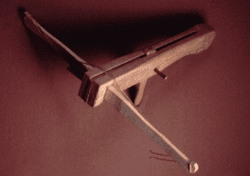The Crossbow
The earliest representations we have of the crossbow date from 400 BCE, in China.
By 209 BCE the Chinese army had 50,000 crossbowmen who fought with mass-produced bronze weapons. These crossbows, which were an important weapon in war until rifles were invented, were usually mounted and could fire up to 650 feet. The first pictorial evidence of European hand-held wooden crossbows, like the one shown here, dates to about 1200 CE. Introduced from the East during the Crusades, they were initially outlawed by religious leaders who considered them to be inappropriate for Christian warfare, but their effectiveness in battle soon prevailed over theological concerns. Crossbows, used in war until the 17th century, are still used for sport today.
Method of Construction
Constructed by: Emily L. Nichols
This wooden crossbow is constructed out of ash. The body consists of two sturdy beams separated by spacers. The cross, which goes through the front of the body, is a thinner piece of ash that is shaped and notched so it will bend under pressure. I used nylon masonry twine to sting the bow instead of the historically accurate catgut or waxed linen. The trigger pivots on a dowel in the center of the weapon. A stirrup on the front of the bow allows the person to anchor the bow while pulling the string back to the notch in the trigger. The person then lays a quarrel, or arrow, in the groove in front of the trigger; releasing the trigger fires the arrow.




